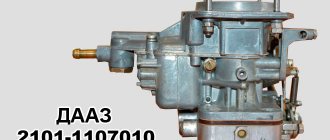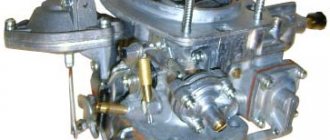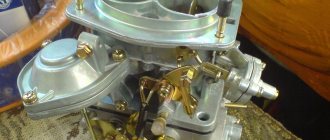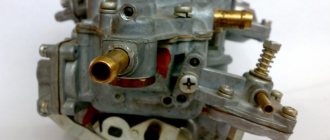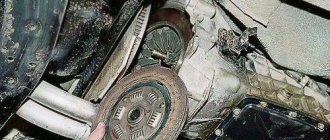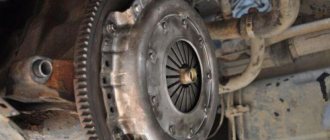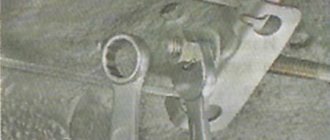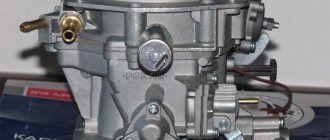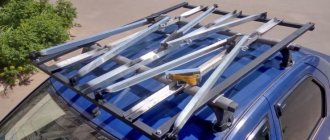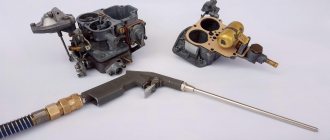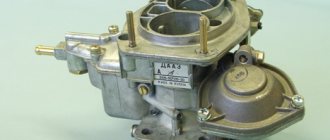On carburetor engines of VAZ 2108, 2109, 21099 cars, the recommended idle speed is 750-800 rpm. At the same time, they must be stable (without frequent misfires and “triples”). It is recommended to adjust the idle speed of engines with carburetors 2108, 21081, 21083 Solex once every six months or if problems arise with engine operation.
Preparatory work
Before carrying out the adjustment, at a minimum, it is necessary to make sure that the spark plugs, high-voltage wires, the distributor cap, the “slider” are in good condition, that the ignition timing is set correctly, that no foreign air is being sucked into the carburetor, and that the fuel pump is in good working order.
In addition, you should warm up the engine to operating temperature (80-90 degrees) and fully open the carburetor air damper, pushing the “choke” handle all the way.
It is not necessary to disconnect and plug the vacuum supply tube from the carburetor to the vacuum ignition timing regulator. Although, after adjusting the idle speed, you can remove it from the fitting on the vacuum regulator housing and check whether there is a vacuum in it when the engine is idling. At correctly adjusted speeds, there should be no vacuum there or it should feel very light.
Tools required for adjusting idle speed
Fine-tuning the idle speed is carried out using a gas analyzer, but not everyone has one. Therefore, it is advisable to have a separate device - a tachometer. If it is not available, you can use the tachometer built into the instrument panel (available on all VAZ 2108, 2109, 21099). You will also need a thin slotted screwdriver.
Adjusting the engine idle speed
Let's start the engine. We turn on the high beam headlights and the heater.
— The simplest way to adjust the idle speed of an engine with a Solex carburetor (2108, 21081, 21083) is to rotate the fuel mixture “amount” screw.
Counterclockwise the revolutions decrease, clockwise they increase. When the screw rotates, its tip acts on the lever of the throttle valve axis of the first chamber of the carburetor and thereby either opens the throttle valve of the first chamber of the carburetor, or, conversely, closes it. Because of this, the air flow passing through the first chamber and the vacuum in the CXX channel increases or, conversely, decreases. Thus, the “quantity” screw regulates the volume of fuel entering the engine cylinders. Accordingly, the engine idle speed will either increase or decrease.
The image shows the screw for adjusting the “quantity” of the fuel mixture of Solex carburetors (2108, 21081, 21083). The carburetor choke lever has been removed for clarity.
More precise tuning involves additional adjustment of the composition of the fuel mixture entering the engine cylinders.
The “quality” screw of the fuel mixture is responsible for this in the 2108, 21081, 21083 Solex carburetors.
To begin with, you can set the initial position of the “quality” and “quantity” screws of the carburetor. This is 3 full turns from the stop of the “quality” screw; the “quantity” screw should be set to the minimum crankshaft speed - 600-700 rpm.
— At the next stage, it is necessary to set the maximum idle speed, using only the “quality” screw of the fuel mixture.
Using a slotted screwdriver, gradually unscrew it from its socket until the idle speed reaches its maximum. It can be 1000 rpm or slightly higher.
— Next, use the “quantity” screw to set the speed to 900 rpm.
We achieve this by slowly rotating it counterclockwise.
— Using the “quality” screw, we set the idle speed at the required level of 750-800 rpm.
To do this, again slowly, wrap it clockwise.
If it is not possible to immediately achieve the desired crankshaft speed, we carry out the adjustment again.
The idle speed of the engine with a Solex carburetor has been adjusted.
— A second, more precise adjustment using both carburetor trim screws will lead not only to a stable and stable engine idle, but also to a decrease in the toxicity of exhaust gases.
— If “dips” occur when you press the gas pedal after adjusting the idle speed in this way, you should slightly turn the “amount” screw of the fuel mixture clockwise, thereby adding a little of the fuel mixture entering the engine cylinders from the idle system. After this, the engine speed will increase slightly, the limit value for engines of VAZ 2108, 2109, 21099 cars is 900 rpm.
— In some cases, it makes sense to modify the carburetor idle system. See “Modification of the idle system of Solex and Ozone carburetors.”
Five more articles on adjusting and tuning the Solex carburetor
Comparative car repair test
On all cars of the “ninth” family, the engines were equipped with domestically produced Solex carburetors. The only exceptions are later modifications, on which the manufacturer installed injection power units. Although far from being the most technically advanced vehicle, the Nine is still popular among car enthusiasts. This is largely due to the car’s maintainability and the relatively low cost of spare parts. In addition, a significant part of the restoration and adjustment work can be carried out by the owner himself, including adjusting the VAZ-2109 and 21099 carburetor, tuning it and cleaning it.
This article will consider only those operations that every car enthusiast can perform with his own hands. Don’t be intimidated by the large number of manipulations - follow the instructions, be careful, and setting up the VAZ carburetor will go no worse than in a service station. This way you can save time and reduce machine maintenance costs.
You can clean and adjust the carburetor for the VAZ nine yourself, in the garage
Preparing the carburetor for tuning
Before you begin adjusting the VAZ-2109 carburetor and other modifications of the model, you should ensure unimpeded access to its parts by removing contamination. If the car is used regularly, then the carburetor needs external flushing only in the case of adjustment procedures or to clean the moving mechanisms if they are heavily contaminated. External washing is carried out using a brush, a clean rag and a liquid that can dissolve oil (gasoline, kerosene or a special cleaning composition). This procedure does not involve removing the carburetor and consists of the following operations:
Design and principle of fuel supply
The VAZ 21099 (Solex) two-chamber carburetor consists of 2 parts: the main body and the cover. The cover contains an electromagnetic valve with an idle jet and a cold start system, which was sometimes equipped with a heating device. A float with a needle or ball valve is attached to the bottom of the lid, and 2 brass tubes with jets at the ends come out from there.
The main body of the carburetor is equipped with the following devices:
The idle speed adjusting screw supports the primary chamber damper and is equipped with a plastic handle. The screw that controls the enrichment of the fuel mixture is hidden in a deep well made in the “sole” of the housing. A diagram of the lower part of the unit is shown in Figure 1.
Now about the functions performed by each system:
- The spring-loaded cold start flap in the closed position ensures the supply of a rich mixture. If there is a bimetallic spiral, it opens automatically as it warms up; without it, it opens manually.
How to set up a VAZ-2109 and 21099 carburetor in a garage
According to the recommendations of experts, adjustment of the VAZ-21099 carburetor should begin with the float chamber. Using this procedure, it is possible to check and establish the optimal fuel level. You need to configure it by following the steps below step by step:
- Start the engine and turn it off after 2-3 minutes;
- After the air filter has been removed and the fuel hose has been disconnected, remove the carburetor cover (to do this, you need to unscrew five bolts). Place the lid on a clean surface with the floats facing up, being careful;
After removing the air filter, disconnect the fuel supply and remove the carburetor cap
- Using a caliper, determine the fuel level in the float chambers: the distance between the edge of the housing and the upper level should be 25.5 mm. If it turns out that the measurements do not comply with the standard, you will have to make an adjustment by bending the tongue of the float bracket and re-measuring the fuel level;
Additionally, you can check how the edges of the floats are located relative to the mating surface of the cover and, if they are not parallel, adjust by acting on the float brackets.
How to adjust the throttle valve actuator
Before you begin adjusting the damper itself, you should check the degree of cable tension. If it turns out that the cable is slack or its tension is too strong, then adjusting the VAZ-21099 carburetor involves starting to adjust the drive in such a way as to prevent the damper from completely closing. To do this, use a wrench set to “13” and tighten the end nut on the cable sheath. Next, use the same key to gradually loosen the locknut.
Now you can set the optimal distance between the carburetor and the tip of the nut. It should be taken into account that in the free position of the accelerator pedal, the damper must be completely closed. All that remains is to tighten the nut and the setting can be considered complete.
How to adjust the air damper actuator
First, the free movement of the thrust must be checked - this will require dismantling the air filter cover. The drive settings can be considered correct only if the air damper is fully opened in the “recessed” position of its handle. If deviations from the norm are detected, read the instructions on how to adjust the carburetor on a VAZ-2109 by performing a series of adjustments.
Throttle adjustment is an important part of the carburetor tuning procedure.
The drive setup process looks like this:
- Loosen the bolt that secures the rod to the lever. After this, you need to recess the drive handle and fully open the air damper, acting on its lever;
- Using pliers, pull the cable out of the sheath and tighten the fixing bolt;
- Next, you need to check how the damper closes when the handle of its drive is extended. Closing must occur completely, otherwise the adjustment operations will have to be repeated.
- The adjustment should be made until you achieve complete opening and closing of the damper in the extreme positions of the drive handle. Make sure that the lever does not come into contact with the cable jacket in any position.
So, at this stage, you have learned how to adjust the carburetor on a VAZ-2109 by setting the optimal operating position of its throttle and air dampers. Now let's move on to adjusting the starting device and idle speed.
Self-adjustment of the starting device
The most precise adjustment of the starting device by setting the values of the starting gaps requires removing the carburetor from the car. But first you need to make sure the integrity of the trigger device diaphragm. To do this, unscrew the four bolts, remove the cover and inspect the diaphragm. If it is suitable for further use, you can continue to make adjustments, otherwise the part will have to be replaced.
Below is a list of operations performed one by one, which describes how to adjust the VAZ-21099 carburetor by adjusting the starting device:
- First you need to close the air damper by turning its lever;
- Using a screwdriver, press down the starter rod;
- The gap formed between the chamber wall and the damper must be measured, and then its value must be compared with the calibration data (indicated by the manufacturer individually for each carburetor model and car);
- If the received data does not correspond to the nominal value, adjustment should be made. The locknut, which is located on the accelerator pump housing, should be loosened and the adjusting screw should be turned with a screwdriver until the required clearance is established;
- Now, having closed the air damper, it is necessary to measure the clearance of the throttle valve of the first chamber. Check the obtained data with the calibration table. If necessary, set the desired gap value by turning the damper adjusting screw.
It is likely that at this stage the adjustment of the VAZ-2109 carburetor can be completed. If you need to adjust idle speed or improve fuel consumption, you can read the relevant guide below.
Disassembling the device
Maintenance of the VAZ 21099 carburetor involves removing, cleaning and adjusting this device after every 60,000 kilometers. When disassembling the carburetor, it is highly recommended not to unscrew the screws securing the air and throttle valves, as this can lead to jamming of the mechanism. In addition, it is prohibited to press out brass tubes that cannot be twisted out.
- First, unscrew the solenoid valve and remove the fuel nozzle from it.
- Then remove the carburetor cover by unscrewing 5 screws.
- After this, use a thin screwdriver to push the float axis out of the holders, take it out and remove the floats.
- Carefully, so as not to damage, remove the cover gaskets.
- Unscrew the needle valve.
- Unscrew the 4 screws of the starter cover and remove it.
- Carefully separate the diaphragm from the cover and remove the spring.
Adjustment in progress
Then unscrew the fuel filter plug and remove it along with the filter element.
- Carefully pry up the accelerator pump nozzles with a screwdriver and remove them.
- Unscrew the 4 screws of the accelerator pump cover and remove it.
- Carefully remove the accelerator pump diaphragm and spring.
- Unscrew the screws of the economizer cover and remove it along with the spring and diaphragm.
- We take out the plastic plug using a screwdriver or a corkscrew and unscrew the mixture quality screw.
- We unscrew 2 emulsion tubes combined with air jets.
- Then we unscrew the fuel jets 1 and 2 of the chamber, located under the emulsion tubes, and, turning the body over, shake them out.
- We unscrew the screw securing the wire and, carefully bending the tabs of the tip, remove the wire from the tip of the mixture quantity screw sensor.
- Unscrew the screw for the amount of mixture.
Return to contents
Signs of a Solex carburetor malfunction
Before adjusting the carburetor on a VAZ 2109, you need to familiarize yourself with the associated faults so as not to repair the unit just like that.
So, the reason after which the VAZ 2109 carburetor is adjusted is considered:
Fuel mixture too rich. Experienced auto mechanics know that for an ideal ratio of fuel and air, a value of 1 to 15 is required. This means that for the combustion of 1 kg of fuel, 15 kg of air are needed. If the mixture is called rich, it means that the fuel level is higher than the nominal level.
Symptoms: the engine is difficult to start, black smoke from the exhaust pipe, spark plugs with black soot and lumbago in the exhaust system. The fuel supply system quickly becomes clogged.
The following signs can be called a consequence of the previous ones and this is:
- Unstable idle speed;
- Increased fuel consumption;
- Deterioration of starting properties;
- Reduced engine response.
The operating principle of the carburetor and fuel supply system forces car owners to perform such a procedure as adjusting the VAZ 2109 carburetor at least once every six months. The mechanism on a car with a carb needs to be lubricated once a month, unlike a car with injection, which has injectors. Everything is extremely easy to adjust.
Causes of failure - we make a diagnosis
Very often, owners of 99 VAZ are faced with the problem of poor engine performance, which can occur in both warm and cold seasons. One of the main reasons for this problem is malfunctions of the carburetor. The symptoms that arise during malfunctions are very easy to notice - the car does not start well, the speed on the tachometer fluctuates, unusual sounds in the form of pops can be heard from the exhaust pipe.
While driving, the VAZ 21099 may stall when changing gears. During acceleration or releasing the gas pedal, jerking and failures in operation are possible. Fuel consumption increases noticeably.
If you find problems with the operation of the VAZ 21099 carburetor, then in case of minor damage it can be repaired or replaced with a new one, if the problems are more serious. Repairing a carburetor is a delicate matter and requires experience in the work. For self-repair, you will need a standard set of tools and, preferably, a book on the maintenance and repair of this type of device.
Reasons for failure of the VAZ 2109 carburetor
The Solex carburetor is a very sensitive device, which contains a large number of small channels. When a huge amount of low-quality fuel passes through them, you may encounter the fact that they become clogged with impurities and stop functioning.
The first thing that may immediately become noticeable is a decrease in idle speed. In the future, the car does not start well and needs carburetor adjustment.
This procedure is divided into several stages:
- Removing the unit
- Disassembly and cleaning
- Assembly and installation
- Carb idle adjustment
↑
Basic faults
When a car malfunctions, it begins to behave unnaturally; experienced owners notice every rustle or jerk. In order to understand that it is the carburetor that is faulty, you need to familiarize yourself with the first symptoms of damage.
- Black smoke comes out of the exhaust pipe, accompanied by “shots”. The engine does not start the first time.
- The idle speed of the vehicle increases or is unstable.
- Fuel is consumed in large quantities.
- The throttle response of the motor mechanism is noticeably reduced.
Such symptoms of car behavior have reasons that lie in damage to certain parts of the control unit:
- The jets are clogged with impurities;
- The solenoid valve stopped working;
- The accelerator pump diaphragm has ruptured and become unusable;
- Air masses enter the housing;
- The accelerator pump nozzle is clogged with dirty impurities;
- The idle speed screws are out of alignment.
The proper operation of the elements depends on the level of gasoline fuel in the chamber and the engine speed at idle. They are the ones that need to be adjusted during car repairs.
However, it often happens that the reason is not in the carburetor, but in the engine itself. Before removing the gearbox, make sure that other mechanisms are working properly.
Removing, disassembling and cleaning the carburetor VAZ 2109
If all of the above symptoms are detected, you can begin to remove and disassemble the carburetor. On a VAZ 2109, repairing a Solex carburetor is possible using a repair kit. It is recommended to purchase a repair kit in advance to immediately replace all gaskets, jets and valves. The table contains data on jets and all necessary valves. The machine must be stationary. When sorting out the parts, the most important thing is not to lose anything.
To remove and configure the device, you need to open the hood and disconnect all the hoses from it. They are mounted on clamps, so it is recommended to stock up on a screwdriver in advance. The next stage is the cable for driving the gas pedal and air damper. Both elements can be removed quite easily. After this, remove the chip from the idle speed economizer. Dismantling is carried out extremely carefully so as not to damage the contacts. Taking everything apart is even easier.
Recommended flow rates of pneumatic economizer jets for various operating conditions
| Operating conditions | Flow capacity cm³/min | Operating conditions | Flow capacity cm³/min |
| Light road conditions with heavy loads (economical adjustment) | 60 | Average road conditions |
You can now remove the four housing nuts that hold the carburetor to the intake manifold. If it is difficult to remove, you can pry it out with a thick screwdriver. Clog the manifold with a rag to prevent foreign particles from getting inside and clean the seating area of any remnants of the old carburetor gasket.
The carburetor itself consists of several elements:
- Top cover
- Bottom cover and float chamber
- Throttle valve block
First of all, the top cover is removed. At the same time, the condition of the needle valve and the condition of the float are checked. The valve should move without jamming and also easily return to its original position. You can immediately check the operation of the accelerator pump drive. All connections should turn easily. The operating principle of many mechanisms is very simple, and they must stand level. It is configured after assembly.
Now you need to separate the throttle body from the bottom cover. Everything is held in place with bolts, so a screwdriver will suffice. Once all components are completely disassembled, they need to be treated with throttle body cleaner or regular gasoline. Parts should be wiped with dry rags.
Removing a faulty device
Carburetor repair is a simple procedure. When removing it, there is no need to replace the pump, fuel pump or battery. The device of the VAZ 21099 car allows you to quickly remove the faulty device. To do this, all you need is a standard set of keys and a little patience.
- First, remove the air filter along with the filter element.
- Then we disconnect the air damper rod. It is located on the right side of the carburetor, in the direction of travel of the car.
- There we also remove the return spring of the gas pedal drive.
- Use a screwdriver to pry up the spring clamp on the gas drive sector and remove it.
- Then we remove the throttle cable from the drive sector.
- We disconnect all the wiring connectors from the carburetor, having previously marked their connection points so as not to confuse them during assembly.
- Loosen the clamps and remove the fuel hoses.
- Unscrew the screw and remove the heating block of chamber 1.
- We remove the crankcase ventilation hose, and then the vacuum tube going to the breaker - the ignition distributor.
- Unscrew the 4 fastening nuts and carefully remove the carburetor.
- To top it off, cover the outlet hole with a clean rag to prevent dirt from getting into it.
Main unit VAZ 21099
Installation is carried out in the reverse order of removal. Now you can begin disassembling and cleaning the carburetor.
Return to contents
This is interesting: What is poured into a car radiator - antifreeze, antifreeze or water?
Installation and assembly of the VAZ 2109 carburetor
After cleaning all the elements, you can assemble it. Check the clearances in the throttle valve block in advance and set them to the nominal values. For each type of unit, you can find all calibration data in reference books. Instead of old gaskets, it is recommended to immediately install new ones to avoid repeated disassembly after two weeks of operation. Installation of parts is done carefully.
Replace the needle valve if necessary. A faulty valve can negatively affect fuel consumption, as it backs up and allows a huge amount of gasoline to pass through the channel cross-section.
It is recommended to lubricate the damper drives, levers and rods with Seledol or Litol 24. It is not recommended to use this lubricant in an environment that comes into contact with gasoline. The grease is suitable only for external parts, such as the plastic joints for the carburetor rods. They may not stand.
The top cover is installed last and only after adjusting the level in the float chamber.
Solex design
The carburetor mechanism of all modifications on the VAZ 2108/2109 is emulsion and consists of two internal combustion chambers. At the top of the carburetor there is a cover that prevents dirt from entering the cavity of the device, and fittings - fuel lines are supplied to them. The middle part is the body itself, into which diffusers and cameras are mounted. At the bottom of the carburetor are the float chamber and throttle valves.
The key elements of the system are:
- accelerator pump;
- float;
- throttle thrust;
- forced idle economizer;
- main dosing system;
- trigger mechanism;
- econostat;
- vehicle idle system.
The principle of operation of the Solex carburetor is that gasoline is supplied through the inlet valve in the fitting. The fuel is directed directly into the float chamber. The fuel level in the cavity must always be at a certain level to avoid dips and jerks in engine operation. Level control is carried out through the movements of a needle valve mechanism.
After the chamber, gasoline is sent to emulsion wells, where it is supplied in strictly limited quantities through fuel nozzles. It is in the wells that air flows break up large drops of gasoline, forming a single air-fuel mixture with it.
The mixture is supplied to diffusers, and through them to the power unit device. Thus, the main task of the carburetor is to form the air-fuel mixture in the desired consistency and direct it to the engine.
The interaction of many elements ensures smooth operation of the motor
This is interesting: Air filter VAZ-2114 - what are they and how to change them?
Do-it-yourself carburetor float chamber level adjustment
Diagram of the float chamber with installation parameters: 1 - float; 2 - tongue; 3 - gasket; 4 - cover.
The level in the float chamber is necessary for smooth operation of the carburetor. A level that is too high will increase the fuel supply, while an insufficient level will reduce the throttle response of a carburetor engine, since the level will not be able to rise in time.
To adjust the level in the chamber, you need to turn the top cover over and bend the float as far as the antennae allow. The distance between the bottom corner and the cover should be 20 mm. If not, bend the tabs and install the top cover. This do-it-yourself adjustment of the VAZ 2109 carburetor is considered nominal. The principle of action here is simple.
Pros and cons of the unit
The Solex carburetor is good because it is able to provide the Nine engine with the necessary amount of fuel in all operating modes, up to the most dynamic. At the same time, it is famous for its efficiency; the actual consumption of a working car on the highway rarely exceeds 6 l/100 km, in the city - 7.5-8 l/100 km. Therefore, many owners of Muscovites, Volgas and old Zhiguli cars were happy to install Solex on their cars. By slightly tuning the VAZ 099 carburetor, it can be installed on a Gazelle or UAZ with an engine capacity of 2.4 and 3 liters.
A little about the disadvantages:
- the unit’s design is quite complex; not everyone can repair and adjust it with their own hands;
- over time, the thin “sole” of the carburetor bends strongly under the influence of the collector temperature;
- the electronic part of the EPH system is quite unreliable and often fails, causing the idle speed to disappear;
- The mixture adjustment screw, recessed in the well and equipped with an elastic band, is very difficult to remove to purge the idle passage.
Adjusting the choke or trigger
Install the carb, but do not install the air filter. Pull the choke out completely and close the valve. In this position, you need to adjust the air damper cable.
Try pulling out and removing the choke several times. The damper should open and close completely without jamming. If everything is done correctly, you can install the air filter in place, connect all the hoses and carburetor drives. It's time to start adjusting the idle speed of the VAZ 2109. Don't forget about connecting the EPHH.
Alternative way
There is a simpler method for determining the correct position of the floats, which does not require measurements. Place the carburetor cover on a flat table and look at the stampings made on the side surfaces. When the floats are in a normally adjusted position, these strips are parallel to the lid.
Then we lift the floats up and look at their bottom, which after lifting should be parallel to the surface of the lid. If necessary, adjust the position of the floats by bending the tongue.
After adjustment work, we assemble the carburetor.
How to set up the carburetor correctly on a VAZ 2109?
The nominal speed of the VAZ 2109 engine should correspond to 750-800 rpm. Adjusting the XX carburetor is necessary to economically maintain engine operation while parked and to warm up as quickly as possible before driving. Without this, the device will not work. Table from those. carburetor characteristics does not have such data. This must be done according to the following instructions, which contain the XX norm. The results and adjustment scheme are stable speeds.
This procedure is carried out if there are problems with the engine or once every six months in accordance with the regulations on technical maintenance of the VAZ 2109. You only need to spend 3-4 minutes on it. The engine warms up to operating temperature using choke or using the accelerator pedal. Next, remove the choke and fully tighten the quality screw. Most likely, the engine will stall. Now the screw is unscrewed exactly three turns and the engine starts again.
Using the quantity adjusting screw, the speed is set to 650-700 rpm. Now turn the quality screw until you get the highest possible idle speed. Again we set the number of revolutions equal to the nominal one. Now we need to rotate the quality again until we get maximum speed. You can regulate this way for a long time.
Now turn the quantity up to 800 rpm. This adjustment is considered correct. If this was not achieved the first time, you need to repeat the procedure again. It is worth recalling that the entire procedure is performed with the headlights on low beam and the stove operating at maximum mode. This is due to the fact that when the voltage drops, the speed drops, so when using these consumers, the speed should be nominal, and when turned off it should increase slightly.
The quality and quantity screw on the carburetor of the Lada 2109 car is located at the rear of the unit. In this regard, adjustment becomes more complicated. Although, it becomes more difficult to regulate, but not as often as on a Zhiguli.
Excellent video on fine-tuning the Solex carburetor on a VAZ 2109
What to do if there is no idle speed on the carburetor nine
Recommended Method
Level control technology includes a number of stages:
- We dismantle the housing of the air filter element. To do this, unscrew the fastening nut of the housing cover, unclip the latches, remove the cover, take out the filter and tighten the 4 nuts that secure the housing to the carburetor.
- Raise the body and disconnect the rubber pipes. We move the body to the side.
- Loosen the clamps securing the fuel pipes going to the carburetor and disconnect them.
- Remove the wire suitable for the idle speed solenoid valve;
- Disconnect the drive cable of the air damper (the “choke” handle);
- Unscrew the 5 screws securing the carburetor cover;
- Having removed the cover, we immediately determine the fuel level in the chambers by lowering a ruler or caliper into one of them until it stops (using its depth gauge). If the measurement shows a level of 25-26 mm, it corresponds to the norm and no adjustment is required;
If the amount of fuel in the chamber is lower or higher than normal, we perform a visual inspection and a series of measurements on the floats, and if necessary, we correct their position.
To carry out adjustment work, place the removed carburetor cover on a flat horizontal surface with the floats facing up.
First, we look at the position of the elements from above. The outer side surfaces of the floats are parallel to the special imprints on the gasket. Deviations can cause the floats to touch adjacent elements and surfaces, causing the fuel level to be incorrect. If necessary, adjust the position of the floats by bending their mounting arms. The next step is to measure the gap between the floats and the gasket. A rod with a diameter of 2 mm is useful here - this is how much the specified gap should be.
If it does not correspond, we bend the tongue of the floats, with which they act on the locking needle. After this adjustment, we check the total height of the floats, which is normally 34 mm. If this is not the case, check the gap again, adjust it if necessary and measure the height again.
The last stage of setup is determining the working stroke of the floats. To do this, place a caliper near the float, mark the distance from its lower corner to the surface of the cover, then lift the float with your hand and mark where the lower corner is.
A working stroke of 15 mm is considered normal; if it differs, it is adjusted by bending the tongue.
Specifications
The VAZ 21099 engine has the following technical characteristics:
Download .xls file
xls
Download picture
Send by email
| OPTIONS | VALUES |
| Years of manufacture | 1990 - 2011 |
| Weight | N. d |
| Cylinder block material | cast iron |
| Motor power system | carburetor |
| Type of cylinder arrangement | In a row |
| Engine displacement | 1.5 liters |
| Engine power | 73 l. With. |
| Number of cylinders | Four |
| Number of valves | Two |
| Piston stroke | 71 millimeters |
| Cylinder diameter | 82 millimeters |
| Compression ratio | 9.8 |
| Torque Nm/rpm | 106 /360 |
| Environmental standards | EURO 2 |
| Fuel | petrol |
| Fuel consumption | 7.8/100 km |
| Oil | 5W-30 |
| Oil volume in crankcase | 3.5 liters |
| When replacing, pour | 3.2 liters |
| Oil change is carried out | every 15 thousand km |
| Motor life | |
| - according to the plant | 125 |
| - on practice | 250 |
The following models are equipped with this motor: 21083, 21093, 21099, 21111, 2115.
Repair
Since most of the engines mentioned are old, they have already undergone at least one major overhaul. There is nothing complicated in this process, but without special equipment, you can only disassemble the motor and put it back together. Therefore, most owners of the power unit turn to a car service center to carry out repair and restoration work.
As for current repairs, the engines have a number of design flaws that have not been corrected for years. Let's consider what eternal problems are present:
- Crackling and metallic ringing. This means it's time to adjust the valves.
- Triple. In this case, you should pay attention to the condition of the air filter and also clean the injectors. The effect occurs when the balance between air and fuel in the cylinders is disrupted.
- Oil leaks. Typically the leak is coming from the valve cover gasket, which means the element needs to be replaced.
- Drop in coolant level in the system. It is worth checking the pipes for wear, and also look for leaks from under the water pump shaft.
- Dieselization. It is worth inspecting the spark plugs and high-voltage wires. The problem may arise from an ignition system that does not completely or incorrectly burn the air-fuel mixture.
Description
Three power units were installed on the VAZ 21099. The four-cylinder 1.3 liter engine with a power of 64 horsepower was not in great demand among car owners, since its power was not enough for such a car.
Buyers were also offered two options for 1.5-liter gasoline engines, which differed in the intake manifold and power system.
Depending on the specific modification, it was possible to remove 73 and 79 horsepower from this engine. Note that the most popular was the carburetor engine, which had a power of 73 hp. s, was distinguished by reliability, fuel efficiency and ease of maintenance.
This modification of the power units was built on the basis of the VAZ 21083 engine. This is an eight-valve engine that used a carburetor power system and had an overhead camshaft. This power unit is made with a cast-iron cylinder block, and thanks to the installation of a carburetor power system, it is easy to operate and easy to repair.
In fact, it was a classic version of the engine, which was installed on the seventh and eighth VAZ models. This engine had a belt drive, which improved its reliability. At the same time, the service work to replace the timing belt was not particularly difficult, so every car owner could carry out such repairs. The timing belt and all rollers are replaced every fifty thousand kilometers.
This engine, provided it was timely and competently maintained, was reliable and had a service life of about 150 thousand kilometers. In practice, the mileage before major repairs could be even 250,000 kilometers.
Servicing this power unit was not difficult. The oil was changed at a mileage of 15 thousand kilometers. This unit did not require any more serious service work.
The only caveat was that it required the use of high-octane fuel. This engine was originally designed to run on 93 gasoline. But attempts to save on fuel and use 76 gasoline led to various kinds of serious damage.
The power indicator is 73 hp. s, while such power figures are achieved at a high 5600 engine rpm. It should be said that thanks to the front-wheel drive layout, the VAZ 21099 shows good dynamics with this engine and is economical. Fuel consumption in mixed mode was 7.8 liters per hundred kilometers.
Tuning
This power unit allows you to increase power to 90-95 horsepower without loss of engine life. Engine tuning could be done by replacing the carburetor with a direct injection system, as well as by installing new lightweight flywheels and crankshafts. The VAZ 21099 engine with an injector produced about 90 horsepower.
There are also options for tuning the VAZ 21099 engine, which involve installing a turbine and supercharger on the power unit. It should be said that the installation of turbines made it possible to obtain a significant increase in power, but the service life of such an engine is significantly reduced. As a result, car owners had to carry out complex overhauls every 70-90 thousand kilometers.
Setting the fuel level
Adjusting the amount of fuel in the chambers of Solex carburetors is a simple procedure and does not require specialized equipment. Although in the factory this adjustment is performed using a special template, which simplifies and speeds up the work. But at home you can do without this template. To carry out adjustment work yourself you need:
With such equipment you can quickly complete all work.

